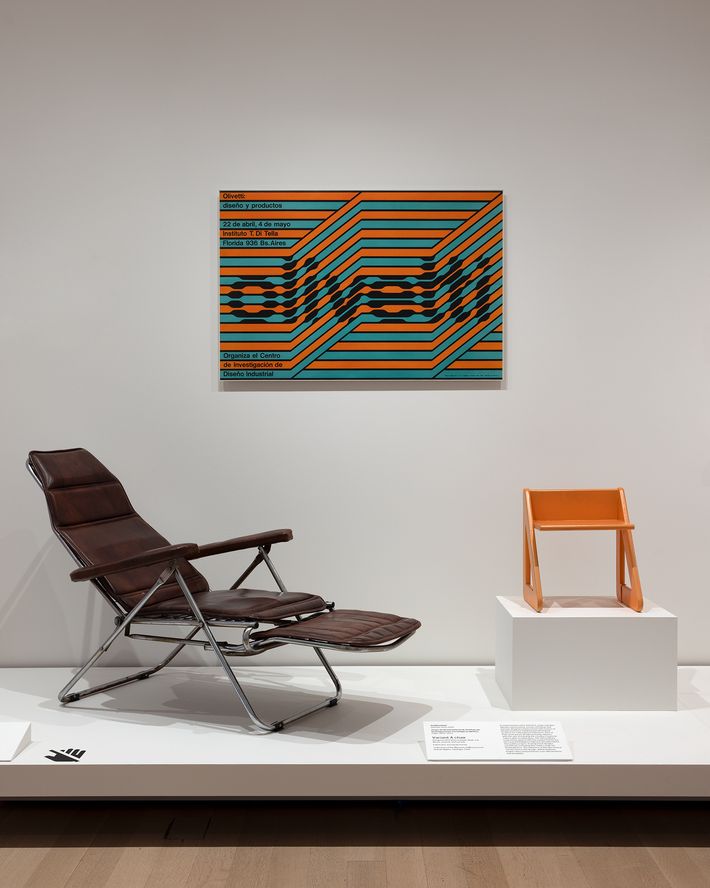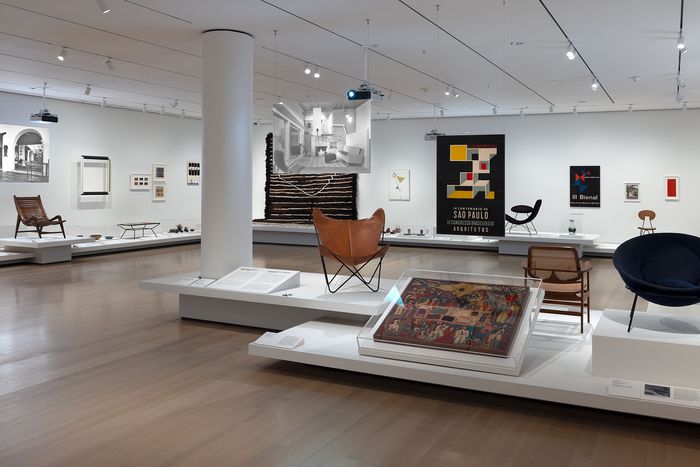MoMA’s ‘Creating Modernity’ Tries to Cover Half a Continent
Photo-Illustration: Curbed; Photos: MoMA
I can count on one hand the number of shows devoted to Latin American design at the Museum of Modern Art over the past 34 years (a.k.a. my adult life). Of these, the most significant was “Latin America in Construction: Architecture 1955-1980” nearly ten years ago, an illuminating, well-researched exhibition organized by Barry Bergdoll, who was then serving as the museum’s chief curator of architecture and design. For the most part, however, it’s been crickets.
Which gave me high hopes for “Crafting Modernity: Design in Latin America, 1940-1980,” which opened in the spring. Billed by MoMA as “the first exhibition by a major American museum to examine Modern design in the region on a broad scale,” it gathers more than 100 mainly domestic objects, including furnishings, textiles, ceramics, and posters. Most interestingly, it is inspired by the work of the influential Cuban Mexican designer and critic Clara Porset, who organized a foundational exhibition on Mexican design at the Palacio de Bellas Artes in Mexico City in the 1950s. But it aims to go bigger and broader, unifying all of Latin America in one big-idea show, and there it flops. (And, to be clear, by “Latin America,” the curators mean Argentina, Brazil, Chile, Colombia, Mexico, and Venezuela; the rest of Central and South America, along with the Caribbean, are left out.) “Crafting Modernity” reveals much about MoMA’s apathetic approach to most of a continent. It’s at once too broad and too terse.
Some of the trouble comes from stretching Porset’s cogent ideas and worldview to an illogical limit. In 1952, she staged an exhibition that explored the tension between craft and mass manufacturing at a moment of breakneck industrialization in Mexico. “El arte en la vida diaria” — “Art in Daily Life” — celebrated good design through an array of utilitarian objects made by man and machine. Handwoven baskets were presented next to stainless-steel cabinets; a clay cooking pot was shown next to a factory-made metal one. Visitors were invited to rest on equipales, the wood and leather chairs typical of Michoacán. The show put a spotlight on the growing field of industrial design in Mexico and prodded Mexican manufacturers to look to their country’s craft traditions for inspiration. Its concepts have informed many shows since.
Photo: Robert Gerhardt/MoMA
Porset’s work, though, exists in a highly specific social context: the Mexico of the ’40s and ’50s, a country, in the wake of a revolution, attempting to construct a national identity by marrying European and Indigenous traditions. Go elsewhere in Latin America and the dynamics are completely different. During that same period, Argentina was experiencing the personality-cult politics of populist Juan Domingo Perón. Urban planners were importing Spanish Revival design from California and Corbusian city plans from France and designing an entire city in the shape of Evita Perón’s head.
How do you reconcile those chasmic differences in a single design show? “Crafting Modernity” does at least acknowledge the heterogeneity. A wall text notes that some Latin American nations “viewed design as an evolution of local craft traditions,” while “others responded to market dynamics, rejecting a focus on the past, embracing international avant-garde movements.” That is correct. But as the premise for an exhibition occupying a small sequence of galleries, it’s broad and squishy: Some nations were inspired by craft, others were not — here’s a show.
“Crafting Modernity” was organized by Ana Elena Mallet, an independent curator from Mexico, in collaboration with MoMA’s Amanda Forment. Mallet has written extensively on Porset, and she organized an important 2022 exhibition at the Museo Universitario de Arte Contemporáneo at the National Autonomous University in Mexico City that marked the 70th anniversary of “Art in Daily Life.” I did not see that show, but the related catalog, published in Spanish and English, is enlightening, tracking legacies of artisanal design in Mexico from 1950 to the present. It also helpfully reproduces Porset’s key writings, which can be difficult to track down in the U.S.
MoMA’s exhibition is loosely arranged around a series of broad themes, like the design of domestic spaces and the rise of design as a profession. But it’s dominated by chairs. There is the sensuous Alacrán (scorpion) chaise longue crafted by a trio of international designers in Mexico in the ‘40s. Prominently featured is the B.K.F. chair of the late 1930s, conceived by three designers in Argentina, a collapsible leather and steel unit that is the precursor to the butterfly chair that came to inhabit countless dorm rooms and twentysomething apartments. One of Porset’s sleek 1950s butaques, a low-slung lounger, is here, too.
The chairs — and accompanying textiles and ceramics — are beautiful. (What I wouldn’t do for an Alacrán.) But these objects largely situate Latin American design within the context of the upper class. (In 1941, the Alacrán retailed for nearly $70 at Bloomingdale’s, the equivalent of about $1,500 today.) The vibe gets downright decadent in some corners of the show. In a glassy room overlooking the museum’s garden, the curators have arranged re-editions of a woven Porset lounger from 1957 crafted by the Guadalajara design company Mexa. I spent time lolling on this lovely sillón, which was delightful. But it made me wonder if I was being tenderized so that I might later purchase a Porset butaque from the MoMA Design Store. (Retail price: $4,639.)
“Crafting Modernity” does not entirely ignore other social classes. There is a reproduction of a toddler-size chair by the Grupo de Diseño Industrial in Chile, conceived for early child-care centers under the socialist government of Salvador Allende. There is also the mystifying inclusion of a poster by the Brigadas Ramona Parra, the mural brigades of the Chilean Communist Party, whose focus was the public sphere, not the home. But, overall, while there were many — many — contextual images of well-to-do homes, there was almost nothing that, say, got into the interior design of social housing.
Photo: Robert Gerhardt/MoMA
I’d be less grumpy about the shortcomings if MoMA engaged Latin American design on the regular. But these exhibitions are rare. If MoMA is going to get serious about this world, it needs to start by dumping the whole concept of “Latin America” and start getting specific. The architecture-and-design department has staged shows about Japanese posters, Russian architectural drawings, and Dutch interior design. There should be comparable shows about Indigenous graphics in Peru and the ways socialism shaped Chilean design in the ’70s. In fact, there was an exhibition about the latter in Santiago late last year: “How to Design a Revolution: The Chilean Road to Design.” It was groundbreaking — down to the reconstruction of a retrofuturistic control room for a utopian data-management project called Cybersyn. (MoMA should be begging the show’s Chilean curators to bring it to New York.)
“Crafting Modernity” could have been a fulfilling enterprise if it kept the focus on Mexico and Porset. Hers is a fascinating story, as is the story of how design helps construct national identity. But it’s a complicated story, full of aesthetic triumphs and convenient elisions. And it deserves more than just pretty places to sit.
“Crafting Modernity: Design in Latin America, 1940-1980” is at the Museum of Modern Art through September 22.






